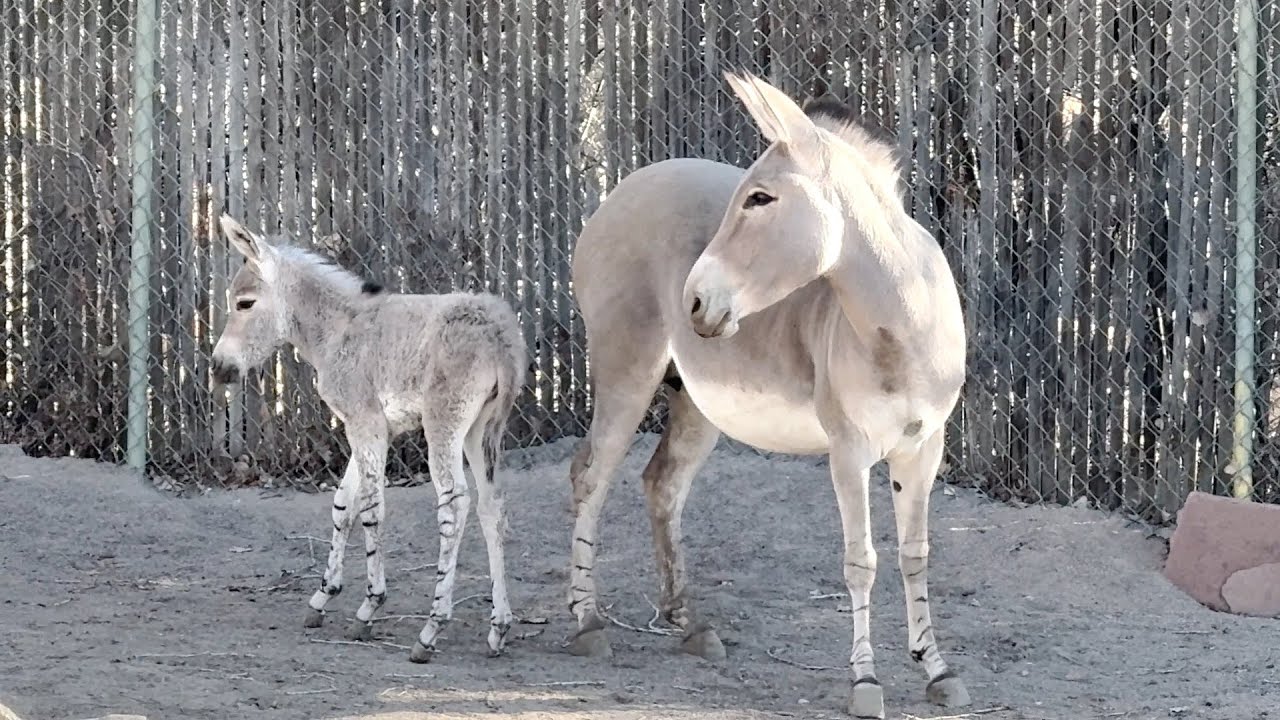- Introduction to the Somali Wild Ass and its critical conservation status.
- Details about the first critically endangered Somali Wild Ass foal born at DZCA.
- Importance of zoo management and wildlife conservation efforts for endangered species.
- Educational insights into the Somali Wild Ass’s habitat, behavior, and threats.
- The role of captive breeding programs in ensuring biodiversity.
The Somali Wild Ass (Equus africanus somaliensis) is one of the most endangered equid species globally. Recognized for its unique physiological characteristics, it inhabits arid regions of the Horn of Africa. Its critically endangered status, as classified by the International Union for Conservation of Nature (IUCN), underscores urgent conservation needs due to habitat destruction, poaching, and competition with livestock for resources.
Amidst this conservation crisis, a beacon of hope has emerged at the Desert Zoo and Conservation Area (DZCA) with the birth of the first Somali Wild Ass foal. This event marks a significant achievement in the fight to save this rare species from the brink of extinction. Captive breeding programs like those at DZCA play a crucial role in wildlife conservation, offering a controlled environment where populations of endangered species, such as the Somali Wild Ass, can be monitored and nurtured.
Our understanding of the Somali Wild Ass begins with its distinct physical and behavioral characteristics. Known for its slender limbs and striking zebra-like stripes on its legs, it is adapted to survive in some of the harshest climates on earth. These adaptations include the ability to go without water for several days and a diet comprising mostly of tough desert vegetation. Their primary threat stems from habitat encroachment due to human settlements, agricultural expansion, and the inherent pressures of living in such an arid environment.
The significance of the first Somali Wild Ass foal at DZCA cannot be overstated. Breeding programs in zoos are meticulously managed to maximize genetic diversity and enhance the survival prospects of critically endangered species. The foal, a fine example of the results of such efforts, provides a valuable genetic resource that could one day help repopulate wild areas where the species has drastically declined. This success story is a testament to the dedication and expertise of zoologists and conservationists working tirelessly to reverse the fortunes of struggling animal populations.
Zoological institutions, like DZCA, have become vital stakeholders in international conservation efforts, offering not only a sanctuary for endangered species but also platforms for research and education. The introduction of the foal in captivity serves as an educational tool, enlightening the public about the intricacies of wildlife conservation and the specific challenges faced by species like the Somali Wild Ass. This knowledge is essential for fostering a broader commitment to preserving biodiversity and ecological balance.
Understanding the behavior and ecology of the Somali Wild Ass is crucial for effective conservation. These animals are known to form small, stable family groups and communicate through vocalizations and body language. They are territorial, with stallions marking their area with dung piles to ward off rivals. Awareness of these behaviors aids conservationists in crafting strategies tailored to preserving viable populations both in captivity and the wild.
Furthermore, threats such as competition with livestock have accentuated the need for conservation interventions. In their native habitat, Somali Wild Asses compete for forage and water resources, which is exacerbated by climate change effects. These challenges highlight the importance of integrated conservation approaches that consider the needs of both wildlife and human communities. Initiatives such as establishing community-based conservation areas and promoting sustainable agricultural practices can mitigate human-wildlife conflict and preserve vital habitats.
Captive breeding and reintroduction programs have proven to be effective in other equid conservation efforts, most notably the Przewalski’s horse, which has seen successful reintroduction in Mongolia. Lessons learned from these initiatives are instrumental in guiding the management of Somali Wild Asses in captivity and exploring potential reintroduction scenarios. Ensuring that these populations remain genetically viable and exhibit natural behaviors are priorities for breeders and researchers alike.
The positive impact of zoo management and conservation efforts extends beyond direct species preservation. It fosters an environment of curiosity and compassion, inspiring individuals to participate in conservation activities at local and global levels. By highlighting the plight and resilience of the Somali Wild Ass, the DZCA’s programs serve as a catalyst for a more profound societal appreciation of wildlife and the responsibilities we share in maintaining the planet’s biodiversity.
In sum, the birth of a Somali Wild Ass foal at DZCA marks a pivotal moment in conservation, providing a model for how integrated breeding, education, and conservation efforts can drive species recovery. It is a compelling demonstration of how dedicated efforts in captivity can contribute meaningly to the preservation of a species, reinforcing the critical role that zoological institutions play in wildlife conservation. Through ongoing research and active management, we can hope that the Somali Wild Ass will not just survive but eventually thrive again in its natural habitat.
*****
Source Description
Oh baby! We’re thrilled to welcome our very first Critically Endangered Somali wild ass foal! Born on January 14 to mom Daisy and first-time dad Kamowa, this energetic and confident foal has quickly become a beloved member of our animal family.
Somali wild ass are one of the rarest wild equids in the world, with fewer than 150 believed to remain in the wild. They are only housed at 11 institutions in North America, including the small but mighty group of four who call Denver Zoo Conservation Alliance home. Every birth is a significant milestone for this Critically Endangered species, and we’re so excited for this foal’s arrival and all the opportunities she represents for our program.
Weather permitting, you may catch a glimpse of this spunky little foal during your next visit. Meet our new foal in this Baby Bulletin, presented by Intermountain Health.
To learn more about how we’re helping protect this Critically Endangered species, check out our latest Zoo Tales: https://denverzoo.org/zootales/dzca-welcomes-first-somali-wild-ass-foal/


